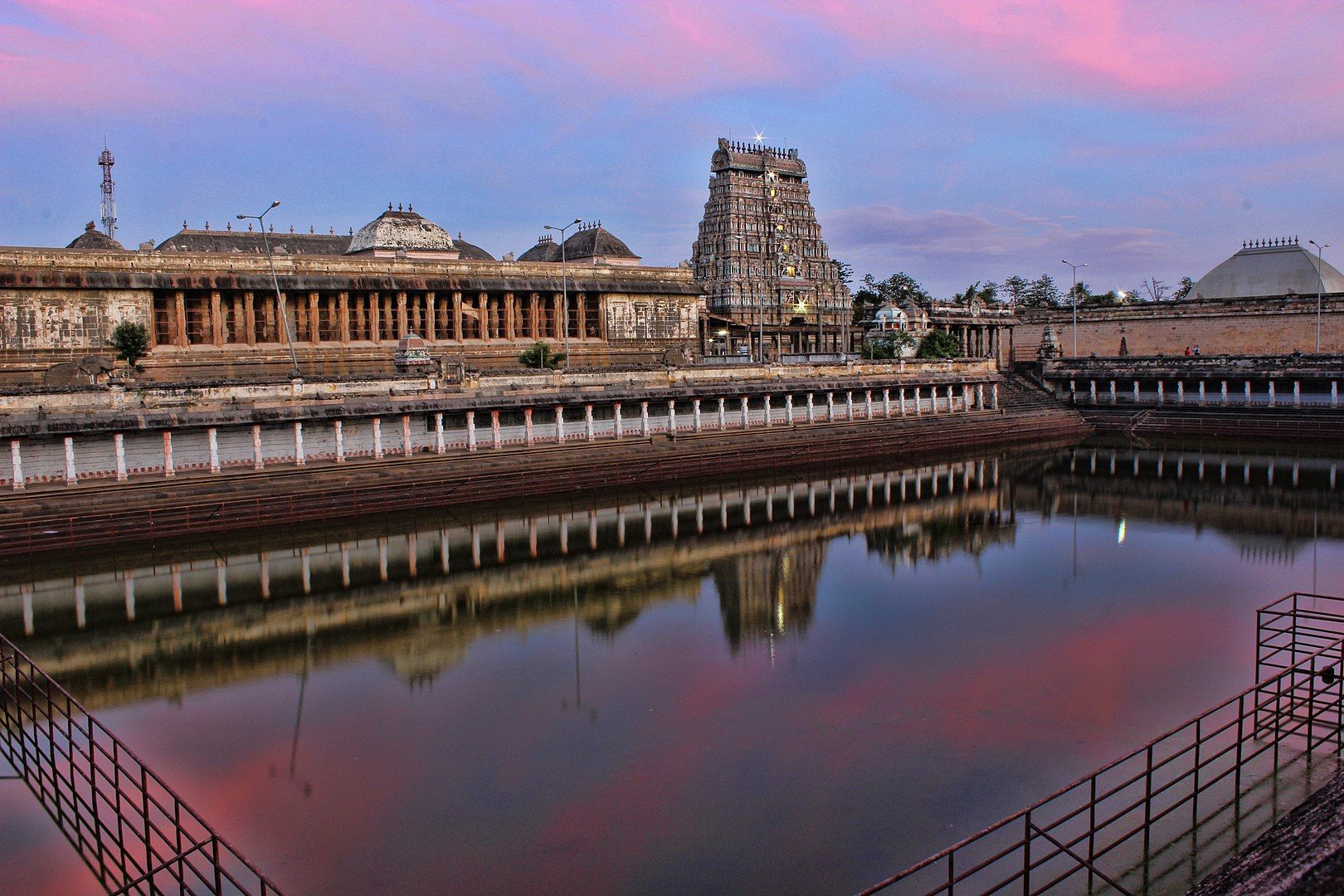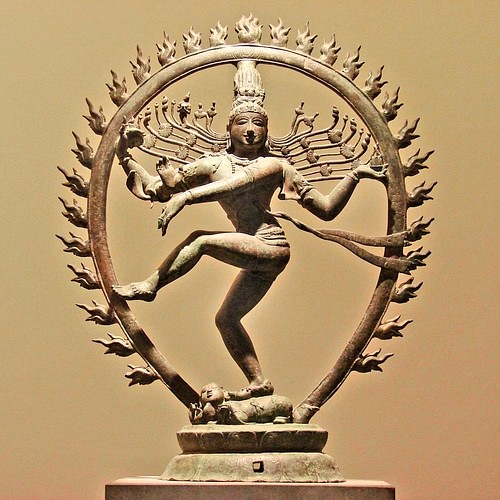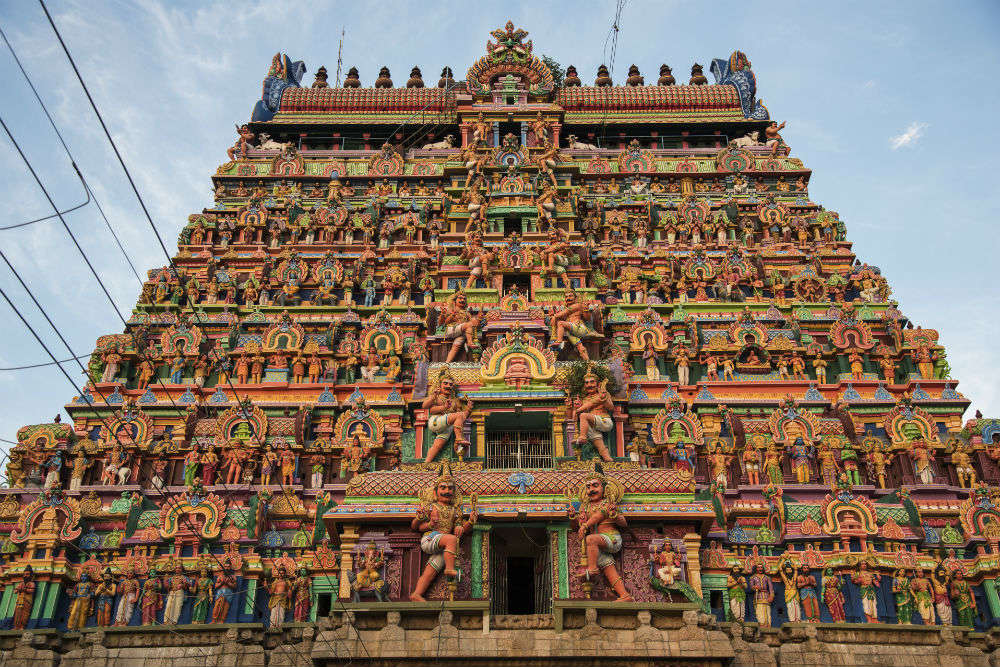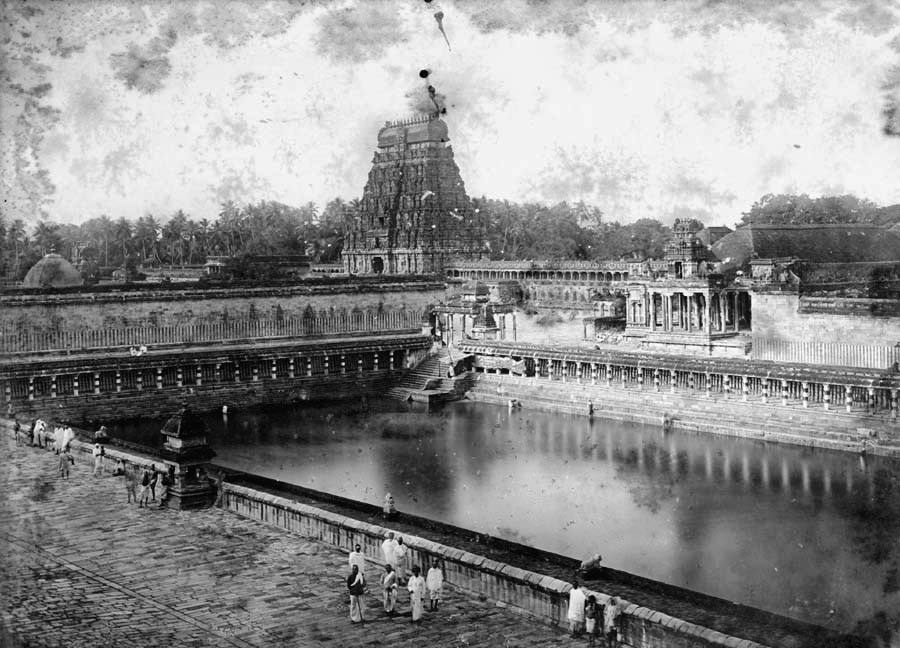About Chidambaram Nataraja Temple

Sure! The Chidambaram Nataraja Temple in Tamil Nadu, India, is a fantastic place dedicated to Lord Nataraja, the cosmic dancer form of Lord Shiva. It's an ancient and awe-inspiring temple with beautiful carvings and stunning architecture. One unique thing about this temple is that the main deity is represented by a curtain with golden peacock designs, making it a mysterious and spiritually significant place. Visitors from all over the world come to admire its beauty and feel its divine presence.
The special about Chidambaram temple

The Chidambaram Nataraja Temple is special for several reasons:
Nataraja, the Cosmic Dancer: The temple is dedicated to Lord Nataraja, the cosmic dancer form of Lord Shiva. The depiction of Lord Nataraja in this temple is one of the most famous and revered representations of this aspect of the deity.
Chit Sabha and Chidambara Rahasyam: The main sanctum sanctorum, called the "Chit Sabha," is unique as it does not house a conventional idol. Instead, it features a curtain with golden peacock designs, representing the mystical "Chidambara Rahasyam" or the secret of Chidambaram. This adds an air of mystery and spiritual significance to the temple.
Dravidian Architecture: The temple showcases magnificent Dravidian architecture, with intricate carvings, towering gopurams, and grand mandapams. The craftsmanship and attention to detail in the temple's design make it a sight to behold.
Cultural and Historical Importance: The Chidambaram Nataraja Temple has a rich history that dates back centuries. It holds immense cultural and religious significance, attracting devotees, scholars, and tourists who seek to experience its spiritual aura and learn about its heritage.
Sacred Dance Festivals: The temple hosts annual dance festivals, including the Natyanjali Dance Festival, where renowned dancers pay tribute to Lord Nataraja through classical dance performances. These festivals celebrate the art form and showcase the temple's connection to the performing arts.
Spiritual Significance: The temple is believed to be located at the heart of the cosmic dance performed by Lord Shiva, symbolizing the cycle of creation, preservation, and destruction. This deep spiritual symbolism attracts seekers and devotees seeking divine experiences.
Overall, the Chidambaram Nataraja Temple stands as a unique and revered place of worship, art, and culture, inviting visitors to immerse themselves in its mystical ambiance and discover the divine beauty of Lord Nataraja's cosmic dance.
What is the structure of Nataraja?

The Nataraja is a form of Lord Shiva depicted in the cosmic dance posture. In this iconic representation, Lord Shiva is shown as a divine dancer performing the "Tandava," a powerful and dynamic dance that symbolizes the cycle of creation, preservation, and destruction in the universe.
The structure of Nataraja typically includes the following key elements:
Dancing Posture: Lord Nataraja is portrayed standing on one leg, with the other leg lifted and bent at the knee. The lifted leg represents liberation from the cycle of birth and death, while the grounded leg symbolizes the material world.
Four Arms: Nataraja is depicted with four arms that represent his divine power and capabilities. The upper right-hand holds a "damaru" (a small drum), which represents the cosmic sound that creates and sustains the universe. The upper left hand holds a flame or "Agni," symbolizing the process of destruction or dissolution.
Mudras (Hand Gestures): The lower right hand is raised in the "abhaya mudra," a gesture of fearlessness and protection, assuring devotees of his divine grace and safeguarding. The lower left-hand points to his lifted foot, signifying the path to salvation and liberation from earthly attachments.
Divine Halo: Lord Nataraja is often depicted encircled by a circular halo or "Prabha mandala," representing the cosmic energy and aura surrounding him during his divine dance.
Serpent Adornment: A serpent is wrapped around Lord Nataraja's waist, representing the cyclical nature of time and the eternal cycle of creation and destruction.
Crescent Moon: A crescent moon is often depicted on Lord Nataraja's matted hair, symbolizing the passage of time and the cyclical nature of the lunar phases.
Dwarf Under Foot: Under Lord Nataraja's raised foot, a dwarf or demon called "Apasmara Purusha" is depicted. The dwarf represents ignorance and the forces of darkness that Lord Shiva subdues through his cosmic dance, promoting wisdom and enlightenment.
The structure of Nataraja, with its intricate symbolism, captures the essence of Lord Shiva's cosmic role as the divine dancer and the eternal rhythm of the universe. This iconic representation is revered and celebrated in Hindu mythology and is often depicted in various art forms and sculptures.
The architectural features of the Chidambaram temple

The Chidambaram Nataraja Temple showcases magnificent Dravidian architecture, characterized by its unique features and grand design. Here are some of the notable architectural elements of the temple:
Gopurams: The temple complex features towering gateways called "gopurams" at the entrance points. These gopurams are elaborately adorned with intricate carvings of gods, goddesses, celestial beings, and mythological scenes. The eastern gopuram is particularly remarkable for its size and detailed sculptures.
Mandapams: The temple has several halls or "mandapams" with impressive architecture. One of the prominent mandapams is the "Thousand Pillar Hall," known for its exquisite stone pillars with intricate carvings of deities and mythological figures.
Nataraja Shrine: The main sanctum sanctorum, known as the "Chit Sabha," houses the Nataraja deity. The shrine is an architectural marvel, featuring a golden roof and a unique feature - a curtain with golden peacock designs that represents the Chidambara Rahasyam.
Shivakamasundari Shrine: Another significant shrine within the temple complex is dedicated to Shivakamasundari, a form of Parvati. This shrine displays intricate artwork and sculptures.
Potramarai Kulam: The temple complex includes a large temple tank called "Potramarai Kulam," which is considered sacred. Devotees perform rituals and take holy dips in the tank during festivals.
Pillared Halls: The temple boasts numerous pillared halls, each adorned with beautiful carvings that narrate mythological stories and depict various deities.
Chariot Procession: The temple has a unique feature - a movable chariot known as the "Ratha" that carries the deity during festive processions. The chariot is a splendid example of wooden craftsmanship and features elaborate carvings.
Artistic Sculptures: Throughout the temple complex, visitors can admire an abundance of finely crafted sculptures depicting various deities, celestial beings, dancers, and mythological scenes. These sculptures showcase the exquisite skill and artistry of the artisans of that era.
The Chidambaram Nataraja Temple's architectural brilliance and artistic splendor make it not only a place of worship but also a living heritage representing the cultural and historical richness of Tamil Nadu. Its unique design and spiritual significance continue to inspire awe and reverence among devotees and tourists alike.
Who is the wife of Lord Nataraja
The wife of Lord Nataraja is Goddess Parvati. In Hindu mythology, Lord Nataraja, an aspect of Lord Shiva, is depicted as the cosmic dancer, and Goddess Parvati is his divine consort. Together, they represent the divine union of masculine and feminine energies, symbolizing creation, harmony, and balance in the universe.
Who made the Chidambaram Natarajar Temple

The Chidambaram Nataraja Temple, also known as Thillai Nataraja Temple, is an ancient Hindu temple located in Chidambaram, Tamil Nadu, India. The temple was built during the reign of the Chola dynasty, a prominent South Indian dynasty, which ruled over a significant part of the Indian subcontinent from the 9th to the 13th century.
The exact date of construction is not entirely clear, but it is believed to have been originally built in the 10th century CE and later expanded and renovated by subsequent rulers. The Chola kings were great patrons of art and architecture, and the Chidambaram Nataraja Temple stands as a magnificent example of their artistic and religious contributions.
The temple is dedicated to Lord Shiva in his form as Nataraja, the cosmic dancer, and is one of the most significant and sacred temples for Shaivites, followers of Lord Shiva, in India. It is renowned for its architectural beauty, intricate carvings, and its unique representation of the cosmic dance of Lord Shiva.
The secret of Chidambaram Temple
The Chidambaram Temple holds great significance and is considered one of the holiest Hindu temples in India. Apart from its architectural and religious importance, the temple has a unique aspect that adds to its mystique. The "Chidambaram Rahasya" or the "Secret of Chidambaram" is an intriguing aspect associated with this temple.
The Chidambaram Rahasya revolves around the deity enshrined in the temple, Lord Shiva as Nataraja, the cosmic dancer. Unlike most Hindu temples where the main deity is represented in the form of a stone or metal idol, the Chidambaram Temple's sanctum sanctorum does not have a physical idol of Lord Nataraja. Instead, it has a curtain (Chidambara Rahasya curtain) concealing the deity.
The belief is that Lord Shiva, in his cosmic dance form, is not bound by a specific form or shape and is omnipresent. Therefore, the absence of a physical idol symbolizes the presence of Lord Shiva in his formless and universal aspect. The curtain represents the veil of illusion (Maya) that conceals the ultimate truth, and only the pure-hearted and spiritually awakened can perceive the divine presence beyond the veil.
During specific rituals and ceremonies, the curtain is drawn aside briefly, offering devotees a glimpse of the empty space within the sanctum. It is believed that only those with genuine and pure devotion can experience the true presence of Lord Shiva during this sacred moment.
The Chidambaram Temple's unique representation of Lord Nataraja and the "Chidambara Rahasya" concept makes it a revered destination for spiritual seekers and devotees who wish to connect with the divine in its most profound and esoteric form. The temple's spiritual significance and the mystery surrounding the hidden deity have attracted devotees, scholars, and curious minds from across the world for centuries.
What is the story of the Nataraja statue

The Nataraja statue depicts Lord Shiva in his form as the cosmic dancer, performing the "Tandava" dance, which represents the eternal cycle of creation, preservation, and destruction in the universe. The story behind the Nataraja statue is deeply rooted in Hindu mythology and symbolism.
According to Hindu mythology, the celestial sage Narada once visited Mount Kailash, the abode of Lord Shiva. Narada was a skilled musician and a master of the veena, a musical instrument. He was proud of his musical abilities and wanted to showcase them to Lord Shiva. However, upon his arrival at Mount Kailash, Narada found Lord Shiva deeply immersed in meditation.
Undeterred by Shiva's meditative state, Narada began to play his veena with great enthusiasm and skill, hoping to gain the Lord's attention. However, Lord Shiva remained unaffected by the music, as he was entirely focused on his spiritual contemplation.
Feeling frustrated and disheartened, Narada realized that his pride and ego had led him astray. He humbly approached Lord Shiva and asked for guidance. Shiva, in his infinite wisdom, understood Narada's predicament and decided to teach him a valuable lesson.
In response to Narada's request, Lord Shiva assumed the form of Nataraja, the cosmic dancer. With flames leaping from his hair, Lord Shiva began to perform the Tandava dance. This mesmerizing dance represented the rhythmic and harmonious movement of the cosmos, with each step symbolizing the birth and destruction of universes, the ebb and flow of existence, and the cyclical nature of creation.
As Narada witnessed the divine dance, he was humbled and enlightened. He realized the insignificance of his ego and the importance of devotion and surrender to the divine. The Nataraja dance taught him that the entire universe is sustained by the cosmic energy of Lord Shiva, and everything in existence is an expression of his divine dance.
The Nataraja statue captures this profound moment of Lord Shiva's dance. It typically depicts him with four arms, symbolizing his all-encompassing power. His upper right-hand holds the drum (damaru), representing the sound of creation, while the upper left hand holds the fire, symbolizing destruction. The lower right hand is in the gesture of fearlessness (abhaya mudra), and the lower left-hand points to his raised foot, signifying liberation and salvation.
The Nataraja statue stands as a powerful symbol of the eternal cosmic order and the interconnectedness of life, art, and spirituality. It serves as a reminder of the dance of existence, where all aspects of the universe are beautifully woven together by the divine rhythm of Lord Shiva's Tandava dance.
which day is more special in chidambaram nataraja temple
The most special and significant day in the Chidambaram Nataraja Temple is the "Maha Shivaratri" festival. Maha Shivaratri is a major Hindu festival dedicated to Lord Shiva, celebrated with great enthusiasm and devotion across India and other parts of the world.
In Chidambaram, Maha Shivaratri holds particular importance due to the temple's association with Lord Shiva as Nataraja, the cosmic dancer. On this auspicious day, devotees flock to the temple to offer prayers, perform special rituals, and participate in various ceremonies.
The festivities on Maha Shivaratri typically include:
Abhishekam: The deity of Lord Nataraja is bathed in various sacred items such as milk, honey, curd, ghee, and holy water as part of a special ceremonial bath known as "Abhishekam."
Rituals and Poojas: Elaborate rituals and special poojas (prayer ceremonies) are performed by the temple priests throughout the day and night to invoke Lord Shiva's blessings.
Night Vigil and Chanting: Devotees often observe a night vigil, staying awake throughout the night and engaging in devotional singing, chanting of sacred mantras, and reading religious texts related to Lord Shiva.
Nataraja Dance: One of the highlights of the festival in Chidambaram is the performance of the Ananda Tandava dance by the temple priests inside the sanctum sanctorum. This ritual dance is believed to be a homage to Lord Shiva's cosmic dance of creation and destruction.
Procession: A grand procession of the deity's idol is taken out in the temple complex, accompanied by music, dance, and fervent chanting by the devotees.
Maha Shivaratri falls on the 13th night and 14th day of the dark fortnight (Krishna Paksha) in the Hindu month of Phalguna (February-March). It is considered one of the most spiritually significant days to worship Lord Shiva and seek his blessings for spiritual growth, inner peace, and liberation.
For devotees of Lord Shiva and admirers of Indian culture, celebrating Maha Shivaratri in Chidambaram Nataraja Temple is a deeply enriching and spiritually uplifting experience.
Can we put the Nataraja statue at home?
Yes, it is possible to have a Nataraja statue at home if you wish to worship Lord Shiva in his form as the cosmic dancer. The Nataraja statue holds great significance in Hinduism and represents the divine dance of Lord Shiva, symbolizing the cyclical nature of creation, preservation, and destruction in the universe.
Having a Nataraja statue at home can serve as a focal point for your devotion and spiritual practices. Before placing any religious or sacred statue at home, consider the following points:
Respect and reverence: Make sure you have a genuine reverence for Lord Shiva and understand the symbolism and significance of the Nataraja statue.
Purity and cleanliness: Keep the area where the statue will be placed clean and well-maintained. It's essential to create a pure and sacred space for worship.
Proper placement: Choose an appropriate location for the Nataraja statue, preferably in a clean and peaceful corner or a designated place for prayer and meditation.
Offerings and rituals: If you decide to worship the Nataraja statue, follow the appropriate rituals and offer flowers, incense, and prayers with sincerity and devotion.
Daily care: Regularly clean and dust the statue to maintain its beauty and sacredness. Treat the statue with care and respect.
Cultural sensitivity: Be mindful of cultural and religious practices if you are not from a Hindu background. If you are unsure about specific customs, seek guidance from a knowledgeable source or a Hindu priest.
It's essential to approach the worship of any deity with reverence and understanding. The presence of the Nataraja statue can enrich your spiritual practice, deepen your connection with Lord Shiva, and remind you of the cosmic dance of existence. However, if you are uncertain about having a Nataraja statue at home or have concerns related to religious beliefs, it's always best to seek guidance from spiritual or religious authorities. ( Shop Now on Pujacraft.com )
The five elements of Chidambaram temple

The Chidambaram Temple is associated with the worship of Lord Shiva as Nataraja, the cosmic dancer. The temple's architecture and symbolism are deeply rooted in Hindu philosophy and the concept of the five elements, also known as the Pancha Bhutas. These five elements are believed to constitute the physical universe, and each element is associated with specific aspects of existence. Here are the five elements represented in the Chidambaram Temple:
Earth (Prithvi): The sanctum sanctorum of the Chidambaram Temple represents the element of Earth. It symbolizes stability, fertility, and the physical manifestation of the divine.
Water (Ap): The temple's "Shivaganga" tank, located within the temple complex, represents the element of Water. The tank is considered sacred, and taking a dip in it is believed to purify devotees both spiritually and physically.
Fire (Agni): The element of Fire is represented through the "Agni Sabha" or "Hall of Fire" in the temple. This hall is located on the southern side of the temple and is associated with various rituals and ceremonies.
Air (Vayu): The "Oonjal" or "Swing" in the temple represents the element of Air. The deities in the temple are often placed on a swing during certain festive occasions, symbolizing the gentle breeze and the movement of air.
Space (Akasha): The Chidambaram Temple's most intriguing aspect, the "Chidambara Rahasya" or "Secret of Chidambaram," represents the element of Space. The curtain that conceals the sanctum sanctorum is considered to represent the boundless and formless nature of space, where Lord Shiva's cosmic dance occurs.
These five elements are an integral part of the temple's architecture and religious significance. They remind devotees of the interconnectedness of the physical world and the divine, encouraging a deeper understanding of the cosmic order and the spiritual aspects of existence.
What is the old name of Chidambaram?

The old name of Chidambaram is "Thillai." The town of Chidambaram, located in the state of Tamil Nadu, India, was historically known as Thillai, and it is still referred to by this name in some contexts. The town's name was later changed to Chidambaram after the establishment of the famous Chidambaram Nataraja Temple, which is dedicated to Lord Shiva as Nataraja, the cosmic dancer.
The name "Thillai" is often associated with the temple and the surrounding region, and it has a rich history and cultural significance. The Chidambaram Nataraja Temple, with its unique architectural features and the concept of the "Chidambara Rahasya," has been an important spiritual and cultural center in South India for centuries, attracting devotees, scholars, and tourists from all over the world.
Chidambaram is famous for?
Chidambaram is famous for several reasons, making it a significant destination in India:
Chidambaram Nataraja Temple: The foremost reason for Chidambaram's fame is the Chidambaram Nataraja Temple. This ancient Hindu temple is dedicated to Lord Shiva in his form as Nataraja, the cosmic dancer. The temple's unique architectural beauty and the concept of the "Chidambara Rahasya" make it one of the holiest and most revered temples in India.
Nataraja Dance Festival: Chidambaram is renowned for hosting the Nataraja Dance Festival, an annual cultural event held at the Nataraja Temple. The festival celebrates classical Indian dance forms, and renowned dancers from all over the country participate, showcasing their talent and paying homage to Lord Nataraja through their performances.
Spiritual and Religious Significance: As the abode of Lord Nataraja, Chidambaram holds immense spiritual significance, particularly for followers of Lord Shiva (Shaivites). Devotees from all over India and beyond visit the temple to seek blessings and immerse themselves in the divine ambiance.
Historical and Cultural Heritage: Chidambaram has a rich historical and cultural heritage, dating back to ancient times. The town has been a center of art, architecture, and learning, and it has been mentioned in ancient texts and inscriptions.
Chola Architecture: The Chidambaram Nataraja Temple exemplifies the grandeur of Chola architecture, showcasing intricate carvings, sculptures, and majestic temple towers (gopurams).
The Ananda Tandava Dance: The Ananda Tandava dance performed by the priests inside the temple is a significant ritual that attracts devotees and visitors. It is a unique dance performed with traditional instruments, invoking the divine energy of Lord Shiva's cosmic dance.
Cultural Tourism: Chidambaram attracts cultural tourists who are interested in exploring the rich cultural heritage of Tamil Nadu, experiencing classical dance performances, and immersing themselves in the spiritual atmosphere.
The Shivaganga Tank: The temple complex includes the sacred Shivaganga tank, where devotees often take a dip to cleanse themselves before entering the temple, adding to the religious significance of the place.
Overall, Chidambaram's fame lies in its spiritual significance, architectural beauty, cultural heritage, and its association with the divine cosmic dance of Lord Shiva as Nataraja.
Conclusion:
The Chidambaram Nataraja Temple, also known as Thillai Nataraja Temple, is a captivating and spiritually significant place that holds a unique charm and allure. Located in the town of Chidambaram, Tamil Nadu, India, the temple stands as a testament to the rich cultural and religious heritage of the region.
The temple's main attraction is its representation of Lord Shiva as Nataraja, the cosmic dancer, captured in the mesmerizing Nataraja statue. This form symbolizes the eternal cycle of creation, preservation, and destruction in the universe, offering a profound insight into the cosmic order.
The concept of the "Chidambara Rahasya," where the sanctum sanctorum conceals the deity with a curtain, adds an aura of mystique to the temple. It reminds devotees of the formless nature of the divine and the presence of the cosmic dance beyond the veil of illusion.
Chidambaram Temple is not only a place of worship but also a hub for cultural celebrations, most notably the Nataraja Dance Festival, which attracts renowned classical dancers from all over India. It showcases the rich heritage of Indian classical dance and fosters a sense of cultural pride and unity.
With its splendid Chola architecture, intricately designed sculptures, and majestic gopurams, the temple stands as an architectural marvel and a living testament to the artistic achievements of ancient India.
Devotees and tourists alike are drawn to Chidambaram to experience spiritual serenity, immerse themselves in vibrant cultural celebrations, and seek blessings from Lord Nataraja. The temple's significance extends beyond the boundaries of religion, touching the hearts and souls of all who visit, leaving an indelible impression on their minds.
Chidambaram Nataraja Temple is not merely a structure of stone and mortar; it is a sacred space where the divine dance unfolds, inviting seekers to partake in the eternal rhythm of existence and connect with the boundless cosmos. It is a testament to the enduring legacy of Hindu spirituality, artistic excellence, and cultural heritage, making it a cherished jewel in India's cultural landscape.


